The United States Navy, United States Coast Guard, and United States National Oceanic and Atmospheric Administration (NOAA) use a hull classification symbol to identify their ships by type and by individual ship within a type. The system is analogous to the pennant number system that the Royal Navy and other European and Commonwealth navies use.

A lightvessel, or lightship, is a ship that acts as a lighthouse. They are used in waters that are too deep or otherwise unsuitable for lighthouse construction. Although some records exist of fire beacons being placed on ships in Roman times, the first modern lightvessel was off the Nore sandbank at the mouth of the River Thames in England, placed there by its inventor Robert Hamblin in 1734. The type has become largely obsolete; lighthouses replaced some stations as the construction techniques for lighthouses advanced, while large, automated buoys replaced others.
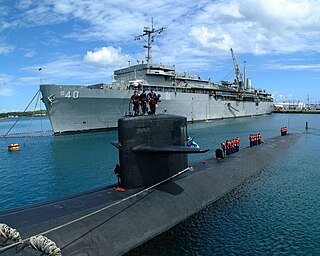
A submarine tender is a type of depot ship that supplies and supports submarines.

HMSM33 is an M29-class monitor of the Royal Navy built in 1915. She saw active service in the Mediterranean during the First World War and in Russia during the Allied Intervention in 1919. She was used subsequently as a mine-laying training ship, fuelling hulk, boom defence workshop and floating office, being renamed HMS Minerva and Hulk C23 during her long life. She passed to Hampshire County Council in the 1980s and was then handed over to the National Museum of the Royal Navy in 2014. A programme of conservation was undertaken to enable her to be opened to the public. HMS M33 is located within Portsmouth Historic Dockyard and opened to visitors on 7 August 2015 following a service of dedication. She is one of only three surviving Royal Navy warships of the First World War and the only surviving Allied ship from the Gallipoli Campaign, the other being the Ottoman minelayer Nusret, preserved in Çanakkale.

Nuclear marine propulsion is propulsion of a ship or submarine with heat provided by a nuclear reactor. The power plant heats water to produce steam for a turbine used to turn the ship's propeller through a gearbox or through an electric generator and motor. Nuclear propulsion is used primarily within naval warships such as nuclear submarines and supercarriers. A small number of experimental civil nuclear ships have been built.

Lloyd's Register Group Limited (LR) is a technical and professional services organisation and a maritime classification society, wholly owned by the Lloyd’s Register Foundation, a UK charity dedicated to research and education in science and engineering. The organisation dates to 1760. Its stated aims are to enhance the safety of life, property, and the environment, by helping its clients to improve the safety and performance of complex projects, supply chains and critical infrastructure.

Bristol Harbour is the harbour in the city of Bristol, England. The harbour covers an area of 70 acres. It is the former natural tidal river Avon through the city but was made into its current form in 1809 when the tide was prevented from going out permanently. A tidal by-pass was dug for 2 miles through the fields of Bedminster for the river, known as the "River Avon New Cut", "New Cut", or simply "The Cut". It is often called the Floating Harbour as the water level remains constant and it is not affected by the state of the tide on the river in the Avon Gorge, The New Cut or the natural river southeast of Temple Meads to its source.
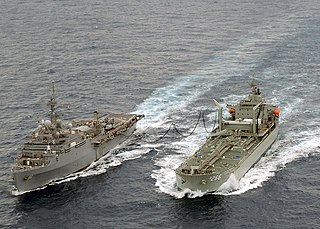
A replenishment oiler or replenishment tanker is a naval auxiliary ship with fuel tanks and dry cargo holds which can supply both fuel and dry stores during underway replenishment (UNREP) at sea. Many countries have used replenishment oilers.
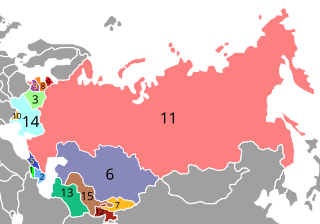
The post-Soviet states, also known as the former Soviet Union (FSU), the former Soviet Republics and in Russia as the near abroad, are the 15 sovereign states that were union republics of the Soviet Union, which emerged and re-emerged from the Soviet Union following its dissolution in 1991.

An auxiliary ship is a naval ship designed to support combatant ships and other naval operations. Auxiliary ships are not primary combatant vessels, though they may have some limited combat capacity, usually for purposes of self-defense.

The American Bureau of Shipping (ABS) is an American maritime classification society established in 1862. Its stated mission to promote the security of life, property, and the natural environment, primarily through the development and verification of standards for the design, construction and operational maintenance of marine and offshore assets.
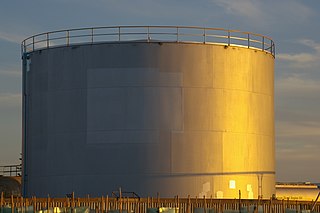
Storage tanks are containers that hold liquids, compressed gases or mediums used for the short- or long-term storage of heat or cold. The term can be used for reservoirs, and for manufactured containers. The usage of the word tank for reservoirs is uncommon in American English but is moderately common in British English. In other countries, the term tends to refer only to artificial containers.
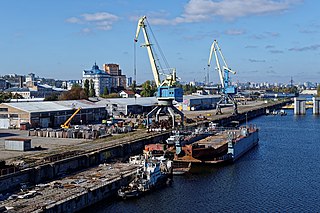
The Kyiv River Port is the main river port of Kyiv, located on the right bank of the Dnieper River in the Podil neighborhood of the city. The port has an own fleet that serves as a shipping company. It also has departments in Pereiaslav and Rzhyshchiv.

Floating nuclear power stations are vessels designed by Rosatom, the Russian state-owned nuclear energy corporation. They are self-contained, low-capacity, floating nuclear power plants. Rosatom plans to mass-produce the stations at shipbuilding facilities and then tow them to ports near locations that require electricity.
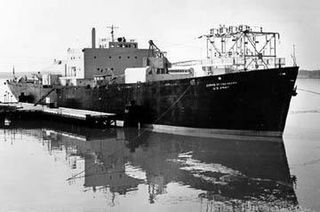
SS Charles H. Cugle was a Type Z-EC2-S-C5 Liberty ship built by J.A. Jones Construction of Panama City, Florida, launched on 13 August 1945. It was ordered by the War Shipping Administration under Maritime Commission Contract number 3145.

The New Union Treaty was a draft treaty that would have replaced the 1922 Treaty on the Creation of the USSR to salvage and reform the Soviet Union. A ceremony of the Russian SFSR signing the treaty was scheduled for 20 August 1991, but was prevented by the August Coup a day earlier. The preparation of this treaty was known as the Novo-Ogarevo process, named after Novo-Ogaryovo, a governmental estate where the work on the document was carried out and where Soviet President and CPSU General Secretary Mikhail Gorbachev talked with leaders of Union republics.
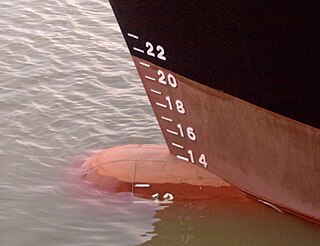
The displacement or displacement tonnage of a ship is its weight. As the term indicates, it is measured indirectly, using Archimedes' principle, by first calculating the volume of water displaced by the ship, then converting that value into weight. Traditionally, various measurement rules have been in use, giving various measures in long tons. Today, tonnes are more commonly used.
Azov Shipyard is the largest ship repair enterprise in the Sea of Azov (Ukraine) specializing in ship repair, shipbuilding, mechanical engineering and cargo transshipment. Azov Shipyard is being managed by Management Company Mariupol Investment Group . Dmitriy Lyashov is the General Director of Azov Shipyard. The shipyard was formerly known as Zhdanov Shipyard. The shipyard has since privatized and is known as Azov ship-repair factory enterprise and is subordinate to System Capital Management.
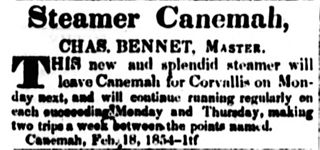
Canemah was one of the first steamboats to run on the Willamette River above Willamette Falls. Canemah was the first steamboat to load grain at Corvallis, the first to carry the mail on the Willamette River, and the first steamboat in Oregon to suffer a fatal boiler explosion.

The MV Karadeniz Powership İrem Sultan is a Liberia-flagged Powership, a floating power plant, owned and operated by Karpowership. Built in 1984 by the Fincantieri Marghera Shipyard in Venice, Italy and christened MV Nikolay Markin, she sailed as a barge carrier under various names and flags until in 2014 she was converted into a powership at the Sedef Shipyard in Tuzla, Istanbul, Turkey. She served in Nacala, Mozambique supplying electricity to Mozambique's power grid for land-locked Zambia. Currently, she serves in the dominican Republic and is stationed in Santo Domingo.

















